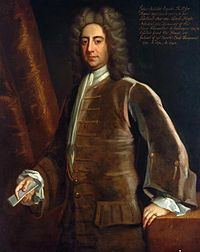Nationality British Name John Aislabie Died June 18, 1742 Succeeded by John Pratt | Preceded by The Viscount Stanhope Political party Whig Role British Politician Party Whigs Children William Aislabie | |
 | ||
Born 4 December 1670 ( 1670-12-04 ) Alma mater St John's College, CambridgeTrinity Hall, Cambridge | ||
Fountains Abbey and Studley Royal Water Garden
John Aislabie or Aslabie (/ˈeɪzləbɪ/; 4 December 1670 – 18 June 1742) was a British politician, notable for his involvement in the South Sea Bubble and for creating the water garden at Studley Royal.
Contents
- Fountains Abbey and Studley Royal Water Garden
- Background and education
- Political career
- Later life and contributions
- References
Background and education
Aislabie's family were originally Yeoman farmers who lived in Hemingbrough. His father George married into the highly influential Mallory family. He attended St. John's College and Trinity Hall at Cambridge. He inherited the Studley estate from his mother's family in 1693, and started serious development of the garden around 1716, becoming the first in England to introduce natural landscaping. (His son William Aislabie added the ruins of Fountains Abbey to the estate.)
Political career
Aislabie was elected as a member of parliament for Ripon in 1695, apparently on the assumption he was a Tory, though his political views were somewhat fluid. He became more active in politics from 1704, especially on the economy. He eventually became associated with the Country Whigs. Under the patronage of Robert Harley he was appointed a Lord of the Admiralty from 1710 in the Tory administration. This proved a precarious appointment as Aislabie's Whig sympathies manifested in votes against the government.
When the Whigs returned to office in 1714, Aislabie was made Treasurer of the Navy. He became an ally of the Earl of Sunderland who became, in effect, Prime Minister in 1718. Sunderland appointed Aislabie as Chancellor of the Exchequer. When in 1719 the South Sea Company proposed a deal whereby it would take over the national debt in exchange for government bonds, Aislabie was a very strong supporter of the scheme and negotiated the contract; he piloted the Bill through the House of Commons. The South Sea Company had been built on high expectations which it could never fulfil, and it collapsed in August 1720. An investigation by Parliament found that Aislabie had been given £20,000 of company stock in exchange for his promotion of the scheme. He resigned the Exchequer in January 1721, and in March was found guilty by the Commons of the "most notorious, dangerous and infamous corruption". He was expelled from the House, removed from the Privy Council, and imprisoned in the Tower of London.
Later life and contributions
After his release from prison, he retired to his estate and continued the development of the gardens.
The obelisk in the Market Square, Ripon, the first in England, was provided by John Aislabie in 1702.
In 1723 Aislabie constructed "Waverley Abbey House" on the site of former Cistercian Waverley Abbey in Surrey.
John's son William Aislabie would also serve in Parliament for the Ripon constituency.
